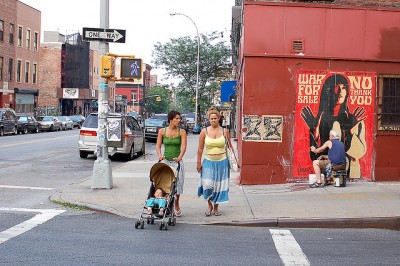What if gentrification could solve the problems of inner city public schools?
The root problem behind the poor academic achievement in most struggling inner city schools is concentrated poverty. Being poor, while not a guarantee of low achievement in itself, is attached to all kinds of other problems that can hurt a child’s academic chances: poor health, domestic violence etc.
The new education reformers, including people like Michelle Rhee, the former D.C. chancellor, argue that good teachers can overcome all of these problems. But for years, schools with high numbers of poor children have had a hard time attracting the best teachers, who usually can have their pick of places to teach. Often, they’d rather teach in middle class schools, where the money is better, the support is stronger, and the children are easier to educate.
For decades, school desegregation was one method of trying to even out the playing field; busing often (but not always) reduced the concentration of poverty in inner city schools. Now, school desegregation has faded as an option after the 2007 Supreme Court decision that limited the use of race-based busing, and student assignment plans based on income status, once imagined as a possible new wave of desegregation, are also on the outs.
For those who favor the idea of attacking the problem of inner city schools by trying to dissolve concentrated poverty, gentrification – a form of de facto integration – seems like a tempting opportunity. Inner city neighborhoods across the country have been transformed in recent decades as young middle and upper class families have rejected the suburbs and exurbs in favor of cities (though not in the most destitute places like Detroit and Camden). In New York City especially, this has been the trend.
But de facto integration is also fraught with problems. An article in Capital New York this week documents the conflicts that roiled one school in Williamsburg, Brooklyn, where artsy, liberal white parents began sending their children to a poor-performing school, P.S. 84, that had traditionally been filled with low-income Hispanic children. The potential for a transformation at the school was marred by resentment, misunderstandings and power struggles. And although the end of the story is upbeat about a new effort at mingling the two groups inside the school walls, the author, Greg Hanlon, writes: “There’s no turning back the tide of gentrification and changes to the neighborhood, which is getting whiter and thicker with children by the day.”
And so this is an inherent problem with gentrification, if left unchecked, as a school reform: that eventually, mixed neighborhood is likely to end up completely wealthy as low-income residents are pushed out by rising rents and home prices. In Williamsburg, the Hispanic population dropped precipitously in the last decade, according to new census numbers, from 40% of Williamsburg’s population in 2000 to only 30% last year. In a few years, the concentration of poverty at P.S. 84 may not be a problem anymore; soon enough, most of the poor students will likely be gone.




